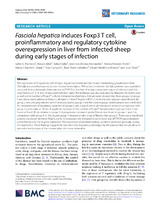Mostrar el registro sencillo del ítem
Fasciola hepatica induces Foxp3 T cell, proinflammatory and regulatory cytokine overexpression in liver from infected sheep during early stages of infection
| dc.contributor.author | Pacheco, Isabel | |
| dc.contributor.author | Abril, Nieves | |
| dc.contributor.author | Zafra Leva, Rafael | |
| dc.contributor.author | Molina-Hernández, Verónica | |
| dc.contributor.author | Morales‑Prieto2, Noelia | |
| dc.contributor.author | Bautista Pérez, María José | |
| dc.contributor.author | Ruiz-Campillo, María Teresa | |
| dc.contributor.author | Pérez Caballero, Raúl | |
| dc.contributor.author | Martínez Moreno, Álvaro | |
| dc.contributor.author | Pérez, José | |
| dc.date.accessioned | 2024-02-08T10:25:28Z | |
| dc.date.available | 2024-02-08T10:25:28Z | |
| dc.date.issued | 2018 | |
| dc.identifier.isbn | 1297-9716 | |
| dc.identifier.uri | http://hdl.handle.net/10396/27283 | |
| dc.description.abstract | The expression of T regulatory cells (Foxp3), regulatory (interleukin [IL]-10 and transforming growth factor beta [TGF-β]) and proinflammatory (tumor necrosis factor alpha [TNF-α] and interleukin [IL]-1β) cytokines was quantified using real time polymerase chain reaction (qRT-PCR) in the liver of sheep during early stages of infection with Fasciola hepatica (1, 3, 9, and 18 days post-infection [dpi]). Portal fibrosis was also evaluated by Masson’s trichrome stain as well as the number of Foxp3+ cells by immunohistochemistry. Animals were divided into three groups: (a) group 1 was immunized with recombinant cathepsin L1 from F. hepatica (FhCL1) in Montanide adjuvant and infected; (b) group 2 was uniquely infected with F. hepatica; and (c) group 3 was the control group, unimmunized and uninfected. An overexpression of regulatory cytokines of groups 1 and 2 was found in all time points tested in comparison with group 3, particularly at 18 dpi. A significant increase of the number of Foxp3+ lymphocytes in groups 1 and 2 was found at 9 and 18 dpi relative to group 3. A progressive increase in portal fibrosis was found in groups 1 and 2 in comparison with group 3. In this regard, group 1 showed smaller areas of fibrosis than group 2. There was a significant positive correlation between Foxp3 and IL-10 expression (by immunohistochemistry and qRT-PCR) just as between portal fibrosis and TGF-β gene expression. The expression of proinflammatory cytokines increased gradually during the experience. These findings suggest the induction of a regulatory phenotype by the parasite that would allow its survival at early stages of the disease when it is more vulnerable. | es_ES |
| dc.format.mimetype | application/pdf | es_ES |
| dc.language.iso | eng | es_ES |
| dc.publisher | Springer | es_ES |
| dc.rights | https://creativecommons.org/licenses/by/4.0/ | es_ES |
| dc.source | Pacheco, I.L., Abril, N., Zafra, R. et al. Fasciola hepatica induces Foxp3 T cell, proinflammatory and regulatory cytokine overexpression in liver from infected sheep during early stages of infection. Vet Res 49, 56 (2018). https://doi.org/10.1186/s13567-018-0550-x | es_ES |
| dc.subject | Portal Fibrosis | es_ES |
| dc.subject | Infected Group | es_ES |
| dc.subject | Chronic Fascioliasis | es_ES |
| dc.subject | Triclabendazole | es_ES |
| dc.subject | Fasciola hepatica | es_ES |
| dc.subject | Liver | es_ES |
| dc.subject | Citokynes | es_ES |
| dc.subject | Early Stages | es_ES |
| dc.title | Fasciola hepatica induces Foxp3 T cell, proinflammatory and regulatory cytokine overexpression in liver from infected sheep during early stages of infection | es_ES |
| dc.type | info:eu-repo/semantics/article | es_ES |
| dc.relation.publisherversion | https://doi.org/10.1186/s13567-018-0550-x | es_ES |
| dc.relation.projectID | info:eu-repo/grantAgreement/EC/H2020/635408 (PARAGONE) | es_ES |
| dc.relation.projectID | Gobierno de España. AGL2015-67023-C2-1-R | es_ES |
| dc.rights.accessRights | info:eu-repo/semantics/openAccess | es_ES |

